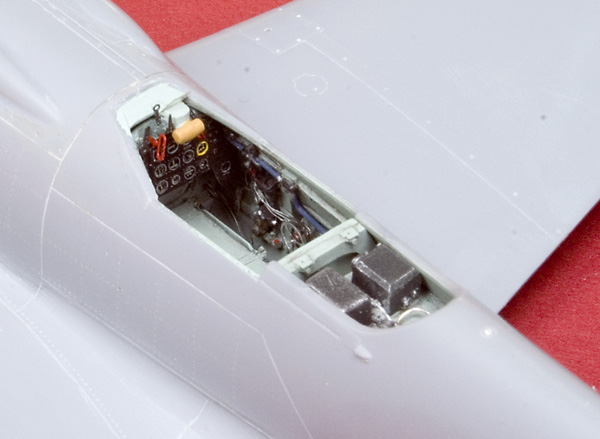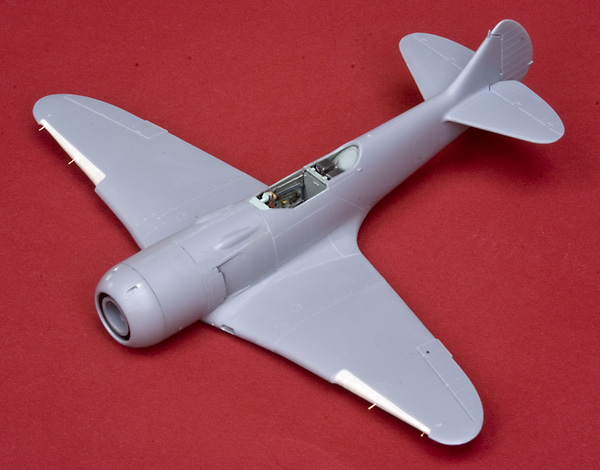|
Gavia's 1/48 scale
Lavochkin La-7
by Kai Roether

|
Lavochkin La-7 |

Eduard's 1/48 scale La-7 Weekend Edition is available from Squadron.com for less than $12.00!
In 1943, ZAGI (the Soviet Central Institute for Hydrodynamics and Aerodynamics) received orders to research options to improve the already successful fighter Lavochkin La-5FN.
The essential requirements were to reduce weight and improve aerodynamic quality.
Many improvements were introduced into the new La-7 fighter. The visible changes were new positions of oil cooler and supercharger intake. The result was a higher top speed of 660km/h (La-5FN 620km/h). The front line units received their first La-7s in autumn of 1944. Quality fluctuations of the engine and FODs because new rear oil cooler position made for some unhappy mechanics. But the pilots loved their new fighter.
After the end of war, the La-7 was quickly retired. The La-7 was a disposable product of wartime - cheap and quick in production and build for no long lifetime. The manufacturer offered a guarantee for 2 years.

The La-7 therefore went the way of other frontline fighters of Soviet production such as the Yak-9U, Yak-3.
The 1. Czechoslovakian Fighter Regiment was also equipped with Lavochkin fighters - first with La-5FN, which saw active service during the war and later (28.04.1945) the La-7 was introduced. The figters were newly built and came from the Gorki production line. Together with the Spitfire Mk. IX and S.99 (Czech built Bf-109) the La-7 was the core of Czech fighter flying. Czech pilots were the only ones who flying these three fighters.
The comparative reports between these three diverse fighters from Czech pilots are very interesting (check publication from MBI, see below).
Czechoslovakia was the sole foreign user of La-7. In 1950, the last example was written off.
The build was inspired by the publication from MBI and the CD of Pilawski/Banyai-Riepl (see references). After the war, the original Soviet stars were overpainted and the Czech roundels were applied.
The model was built using Gavia’s kit. The parts are very well detailed and the outline captures the outline of the original well, except the fuselage behind the cockpit from above - it is to narrow. I decided to leave it as it is.
First I built the wheel wells. Some structural detail was added from wire to acheive a more realistic look. The intakes around the wells are in the kit and "snapped" in place. The next things were the flaps. I used photo-etched parts from Eduard and glued and filled with super glue. After that, the wing-halves were glued together.
The slats were completely scratch built. First I cut the moulded-in slats from the wings. Then I filled the gap with 2-part "Magic sculp". With wet fingers the nearly form where moulded. After drying the exact form where scrapt and sanded. The wing based bottom section were finished. Now I aplied bare metall foil as separation layer. Over that came another shift of "magic sculp". Than wet finger moulding nearly form an let it drying. Now I sanded it down to the level of wing. Remove the part very carefully and voila - perfect slats. The aseambly followed after the painting. One specific feature is noteworthly - the slats of La-7 swayed outboard when deployed - not straight ahead like the Bf-109.

Next was the cockpit. I used NeOmega resin parts with any wheels and little details from Eduard PE and any wire with different diameter. The instrument panel is from Eduard PE-set in combination with acetate-film.
In the bottom of the cockpit a pair of stringers where added with thin strips of styrene. For diplaying open canopy the middle part has to replace with a thinner alternative. I used the filled kit part as stamp for making a new one with heating material from any transparency packing.

I want to display the motor louvre in open position. The kit has only a closed part in styrene. Konsequently the kit has no further details behind the louvre. I used a Motor from Tamyia Fw-190. In Front of this came a exactly trimmed 72'er MiG-23 radom in opposite direction. This let positinig the Motor deep enough in the fuselage. In front of this came the correct part for an open louvre. I picked it from PE-set of Part (Poland). Eduards PE-part for open louvre are completely wrong.
After painting the motor section (steel) and the cockpit and a slightly washing with oil-paints the fuselage where put together. Then the fuselage where joined with wings. Any filling (with super glue again - because of ease of rescribing) and rescribing made the bird ready for painting.
For painting I used colours from "White Ensign". They have the most soviet WWII colours in there portfolio. First I sprayed the lighter gray (AMT-11). Then I mxed the darker Greengray (AMT-12) with a little bit of AMT-11 and sprayed the darker areas. Afterwards I used unmixed AMT-12 for painting the overpainted parts. In the same manner I painted the lower surfaces. First lengthened AMT-7 (light blue), then unmixed AMT-7 for overpainted areas.
After very decent weathering with Pastel chalk and colour chipping with silver (email from Revell) the bird could be final assambled. The wheels were corrected in shape (to square), the positinig lights (from CMK), antenna, solder pito tube (copper tube) and the last the middle section of canopy.
This was a fun build of an outstanding aircraft. I believe it will not be the last one I build.
Model and
Text and Images Copyright © 2008 by Kai Roether
Page Created 25 March, 2008
Last Updated
27 March, 2008
Back to HyperScale
Main Page |
Home
| What's New |
Features |
Gallery |
Reviews |
Reference |
Forum |
Search